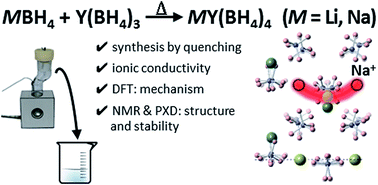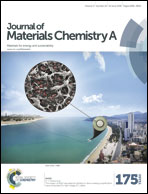Solid state synthesis, structural characterization and ionic conductivity of bimetallic alkali-metal yttrium borohydrides MY(BH4)4 (M = Li and Na)†
Abstract
Two bimetallic borohydrides, lithium yttrium tetraborohydride, LiY(BH4)4, and sodium yttrium tetraborohydride, NaY(BH4)4, have been synthesized by thermal treatment and quenching of ball-milled precursors. LiY(BH4)4 crystallizes in the space group P![[4 with combining macron]](https://www.rsc.org/images/entities/char_0034_0304.gif) 2c and NaY(BH4)4 in C2221 and the compounds are isostructural to LiSc(BH4)4 and NaSc(BH4)4, respectively. Both LiY(BH4)4 and NaY(BH4)4 are built from the complex anions of [Y(BH4)4]−. The unit cell volumes per formula unit of the bimetallic compounds LiY(BH4)4 and NaY(BH4)4 are significantly larger compared to those of the constituent components (14% and 7.5% unit cell expansion, respectively), which may contribute to the mobility of the Li+ and Na+ cations. The ionic conductivities of LiY(BH4)4 and NaY(BH4)4 at room temperature, measured by impedance spectroscopy, are σ = 1.26 × 10−6 and 6.92 × 10−7 S cm−1 respectively, and are improved compared to those of the precursors. DFT calculations were used to optimize the structures and identify a possible mechanism for the Na ion mobility. In addition, they provide the basis for assignment of the 11B NMR parameters determined by 11B MAS NMR for the two boron sites in NaY(BH4)4.
2c and NaY(BH4)4 in C2221 and the compounds are isostructural to LiSc(BH4)4 and NaSc(BH4)4, respectively. Both LiY(BH4)4 and NaY(BH4)4 are built from the complex anions of [Y(BH4)4]−. The unit cell volumes per formula unit of the bimetallic compounds LiY(BH4)4 and NaY(BH4)4 are significantly larger compared to those of the constituent components (14% and 7.5% unit cell expansion, respectively), which may contribute to the mobility of the Li+ and Na+ cations. The ionic conductivities of LiY(BH4)4 and NaY(BH4)4 at room temperature, measured by impedance spectroscopy, are σ = 1.26 × 10−6 and 6.92 × 10−7 S cm−1 respectively, and are improved compared to those of the precursors. DFT calculations were used to optimize the structures and identify a possible mechanism for the Na ion mobility. In addition, they provide the basis for assignment of the 11B NMR parameters determined by 11B MAS NMR for the two boron sites in NaY(BH4)4.


 Please wait while we load your content...
Please wait while we load your content...